 |
LTI611S- LAND TRANSPORT SAFETY AND INFRASTRUCTURE CONSIDERATIONS- 2ND OPP- JULY 2024 |
 |
1 Page 1 |
▲back to top |
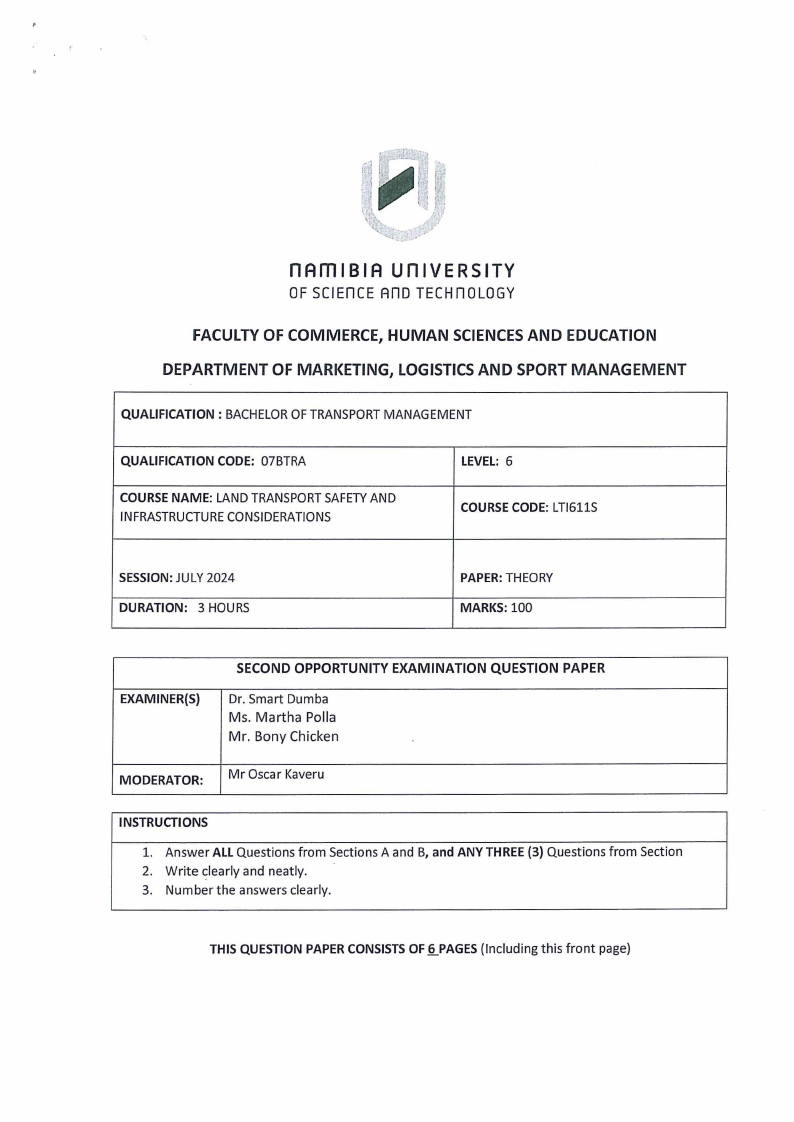
n Am I 8 I A Un IVERS ITY
OF SCIEnCE TECHnOLOGY
FACULTY OF COMMERCE, HUMAN SCIENCESAND EDUCATION
DEPARTMENT OF MARKETING, LOGISTICSAND SPORT MANAGEMENT
QUALIFICATION: BACHELOROF TRANSPORTMANAGEMENT
QUALIFICATIONCODE: 07BTRA
COURSENAME: LAND TRANSPORTSAFETYAND
INFRASTRUCTURECONSIDERATIONS
LEVEL:6
COURSECODE: LTl611S
SESSION:JULY 2024
DURATION: 3 HOURS
PAPER:THEORY
MARKS: 100
EXAMINER(S)
SECOND OPPORTUNITY EXAMINATION QUESTION PAPER
Dr. Smart Dumba
Ms. Martha Polla
Mr. Bony Chicken
MODERATOR: Mr Oscar Kaveru
INSTRUCTIONS
1. Answer ALLQuestions from Sections A and B, and ANY THREE(3) Questions from Section
2. Write clearly and neatly.
3. Number the answers clearly.
THIS QUESTIONPAPERCONSISTSOF§_PAGES{Including this front page)
 |
2 Page 2 |
▲back to top |
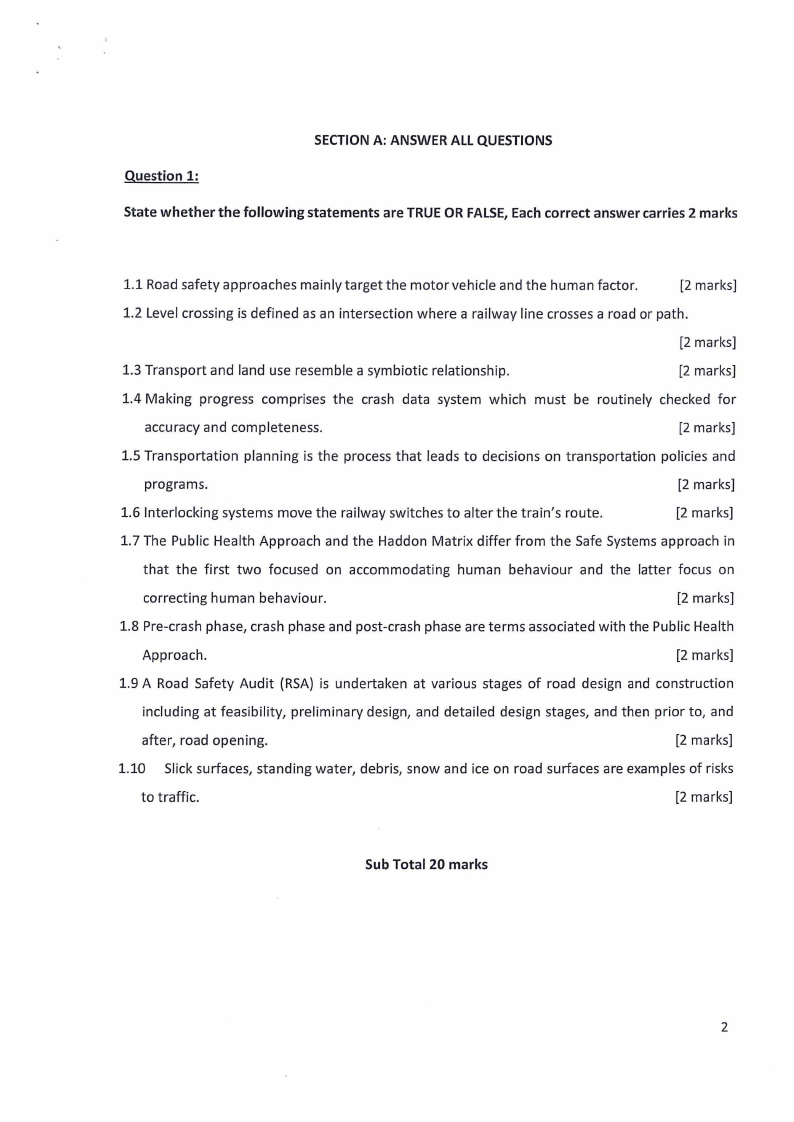
SECTION A: ANSWER ALL QUESTIONS
Question 1:
State whether the following statements are TRUE OR FALSE,Each correct answer carries 2 marks
1.1 Road safety approaches mainly target the motor vehicle and the human factor.
[2 marks]
1.2 Level crossing is defined as an intersection where a railway line crosses a road or path.
[2 marks]
1.3 Transport and land use resemble a symbiotic relationship.
[2 marks]
1.4 Making progress comprises the crash data system which must be routinely checked for
accuracy and completeness.
[2 marks]
1.5 Transportation planning is the process that leads to decisions on transportation policies and
programs.
[2 marks]
1.6 Interlocking systems move the railway switches to alter the train's route.
[2 marks]
1.7 The Public Health Approach and the Haddon Matrix differ from the Safe Systems approach in
that the first two focused on accommodating human behaviour and the latter focus on
correcting human behaviour.
[2 marks]
1.8 Pre-crash phase, crash phase and post-crash phase are terms associated with the Public Health
Approach.
[2 marks]
1.9 A Road Safety Audit (RSA) is undertaken at various stages of road design and construction
including at feasibility, preliminary design, and detailed design stages, and then prior to, and
after, road opening.
[2 marks]
1.10 Slick surfaces, standing water, debris, snow and ice on road surfaces are examples of risks
to traffic.
[2 marks]
Sub Total 20 marks
2
 |
3 Page 3 |
▲back to top |
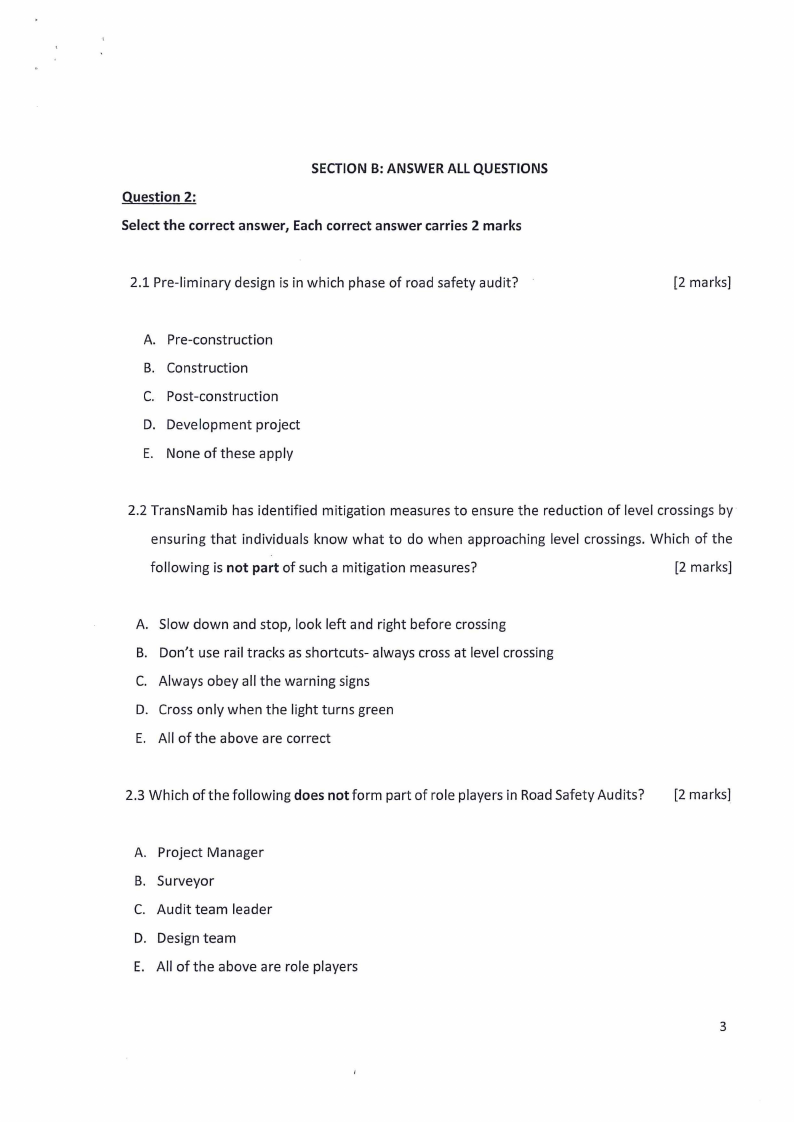
SECTION B: ANSWER ALL QUESTIONS
Question 2:
Select the correct answer, Each correct answer carries 2 marks
2.1 Pre-liminary design is in which phase of road safety audit?
[2 marks]
A. Pre-construction
B. Construction
C. Post-construction
D. Development project
E. None of these apply
2.2 TransNamib has identified mitigation measures to ensure the reduction of level crossings by
ensuring that individuals know what to do when approaching level crossings. Which of the
following is not part of such a mitigation measures?
[2 marks]
A. Slow down and stop, look left and right before crossing
B. Don't use rail tracks as shortcuts- always cross at level crossing
C. Always obey all the warning signs
D. Cross only when the light turns green
E. All of the above are correct
2.3 Which of the following does not form part of role players in Road Safety Audits? [2 marks]
A. Project Manager
B. Surveyor
C. Audit team leader
D. Design team
E. All of the above are role players
3
 |
4 Page 4 |
▲back to top |
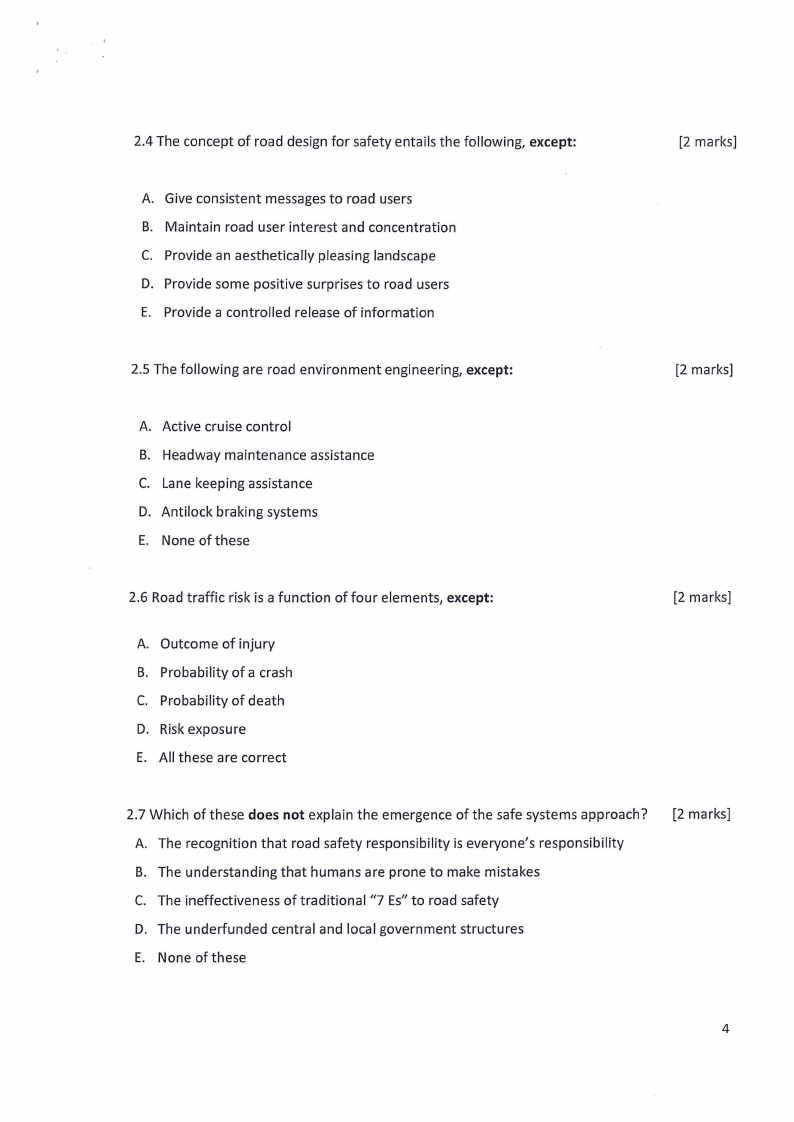
2.4 The concept of road design for safety entails the following, except:
[2 marks]
A. Give consistent messages to road users
B. Maintain road user interest and concentration
C. Provide an aesthetically pleasing landscape
D. Provide some positive surprises to road users
E. Provide a controlled release of information
2.5 The following are road environment engineering, except:
[2 marks]
A. Active cruise control
B. Headway maintenance assistance
C. Lane keeping assistance
D. Antilock braking systems
E. None of these
2.6 Road traffic risk is a function of four elements, except:
A. Outcome of injury
B. Probability of a crash
C. Probability of death
D. Risk exposure
E. All these are correct
[2 marks]
2.7 Which of these does not explain the emergence of the safe systems approach?
A. The recognition that road safety responsibility is everyone's responsibility
B. The understanding that humans are prone to make mistakes
C. The ineffectiveness of traditional "7 Es" to road safety
D. The underfunded central and local government structures
E. None of these
[2 marks]
4
 |
5 Page 5 |
▲back to top |
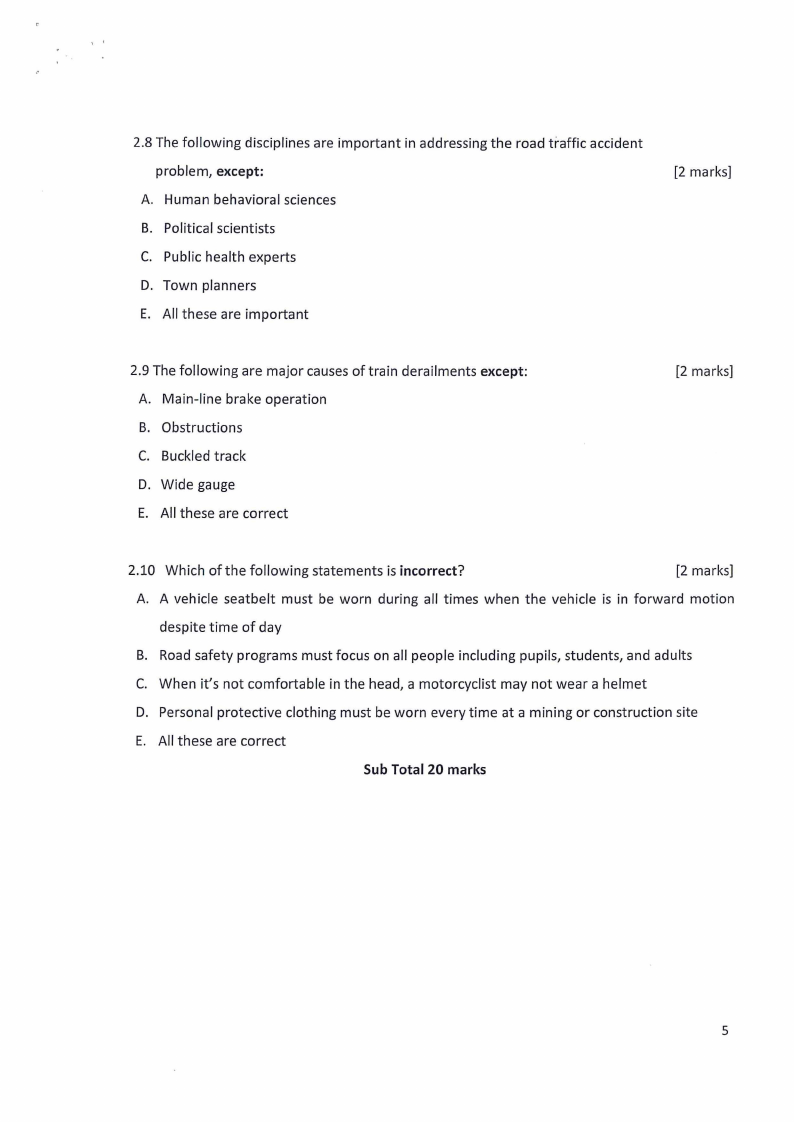
2.8 The following disciplines are important in addressing the road traffic accident
problem, except:
A. Human behavioral sciences
B. Political scientists
C. Public health experts
D. Town planners
E. All these are important
[2 marks]
2.9 The following are major causes of train derailments except:
A. Main-line brake operation
B. Obstructions
C. Buckled track
D. Wide gauge
E. All these are correct
[2 marks]
2.10 Which of the following statements is incorrect?
[2 marks]
A. A vehicle seatbelt must be worn during all times when the vehicle is in forward motion
despite time of day
B. Road safety programs must focus on all people including pupils, students, and adults
C. When it's not comfortable in the head, a motorcyclist may not wear a helmet
D. Personal protective clothing must be worn every time at a mining or construction site
E. All these are correct
Sub Total 20 marks
5
 |
6 Page 6 |
▲back to top |
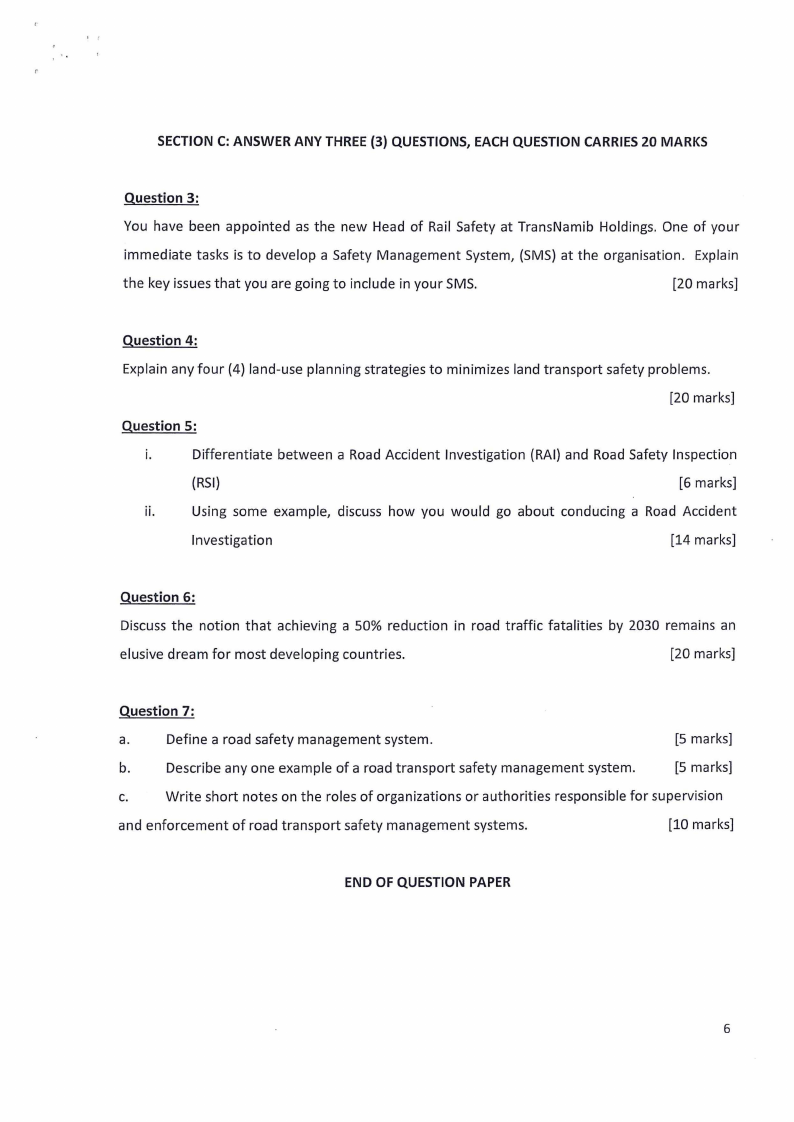
'I
SECTIONC:ANSWER ANY THREE(3) QUESTIONS,EACHQUESTION CARRIES20 MARKS
Question 3:
You have been appointed as the new Head of Rail Safety at TransNamib Holdings. One of your
immediate tasks is to develop a Safety Management System, (SMS) at the organisation. Explain
the key issues that you are going to include in your SMS.
[20 marks]
Question 4:
Explain any four (4) land-use planning strategies to minimizes land transport safety problems.
[20 marks]
Question 5:
i.
Differentiate between a Road Accident Investigation (RAI) and Road Safety Inspection
(RSI)
[6 marks]
ii.
Using some example, discuss how you would go about conducing a Road Accident
Investigation
[14 marks]
Question 6:
Discuss the notion that achieving a 50% reduction in road traffic fatalities by 2030 remains an
elusive dream for most developing countries.
[20 marks]
Question 7:
a.
Define a road safety management system.
[5 marks]
b.
Describe any one example of a road transport safety management system.
[5 marks]
c.
Write short notes on the roles of organizations or authorities responsible for supervision
and enforcement of road transport safety management systems.
[10 marks]
END OF QUESTION PAPER
6





